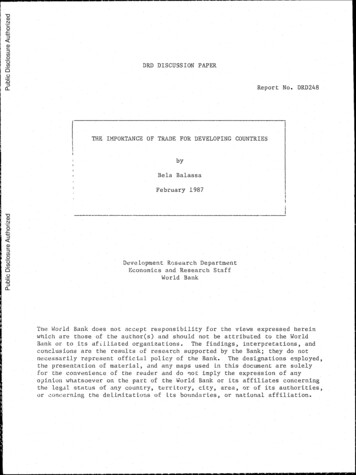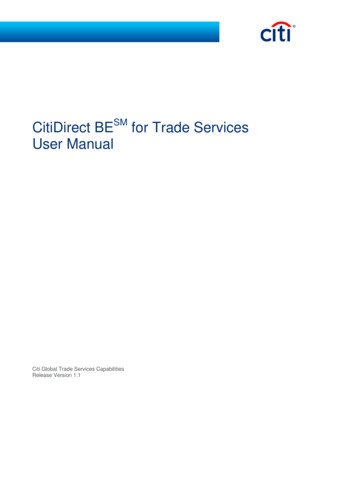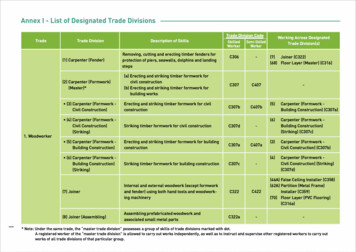
Transcription
Public Disclosure AuthorizedPublic Disclosure AuthorizedPublic Disclosure AuthorizedPublic Disclosure AuthorizedDRD DISCUSSION PAPERReport No. DRD248THE IMPORTANCE OF TRADE FOR DEVELOPING COUNTRIESbyBela BalassaFebruary 1987- - - - - - !iDevelopment R0search DepartmentEconomics and Research StaffWorld BankThe Horld Bank does not accept responsibility for the views expressed hereinwhich are those of the author(s) and should not be attributed to the WorldBank or to its afiiliated organizations. The findings, interpretations, andconclusions are the results of research supported by the Bank; they do notnecessarily represent official policy of the Bank. The designations e ployed,the presentation of material, and any maps used in this document are solelyfor the convenience of the reader and do not imply the expression of anyopinion \vhatsoever on the part of the World Bank or its affiliates concerningthe legdl status of any country, territory, city, area, or of its authorities,or oncerning the deliMitations of its boundaries, or national affiliation.
THE HlPORTANCE OF TRADE FOR DEVELOPING COUNTRIESbyBela BalassaProfessor of Political EconomyJohns Hopkins Univer.sityConsultantWorld BankThis paper was prepared for. the Confer.ence on the Role and Interests of theDeveloping Countries in the Multilater.al Tr.ade Negotiations, held in Bangkok,Thailand, October. 30 -November. 1, 1986, co-sponsored by the ThailandDevelopment Resear.ch Institute and the Wor.ld Bank.The author is indebted to Jagdish Bhagwati, Anne Krueger and CostasMichalopoulos for. helpful comments. The views presented here are those of theauthor, and they should not be attr.ibuted to or. inter.pr.eted as reflectingthose of the Thailand Development Research Institute or the Wor.ld Bank. Thedescr.iptions employed are solely for. the conveninece of the reader. and do notimply the expr.ession of any opinion whatsoever on the part of the ThailandDevelopment Research Institute or. the Wor.ld Bank concerning the legal statusof any countr.y, terr.itory, city, ar.ea, or of its authorities, or concerningthe delineation of its boundaries or. national affiliation.
THE IMPORTANCE OF TRADE FOR DEVELOPING COUNTRIESABSTRACTThis paper indicates the benefits developing countries may derivethrough international trade.It rev1ews recent trends in world trade in majorproduct groups; analyzes the economic performance of developing countriesapplying outward-oriented and inward-oriented policies; and examines therelationship between exports and economic growth.It is further shown thatexternal constraints do not stand in the way of an increasing number ofdeveloping countries adopting outward-oriented policies.Recommendations are de for the adoption of such policies and for developing countryparticipation in multilateral trade negotiations.
The Importance of Trade forDevelop ngCountriesBela BalassaIntroductionParticipation 1n international trade provides a variety of benefitsto developing countries.They may obtain ga1ns through resource allocationaccording co comparative advantage; the exploitation of econom1es of scale andincreased capacity utilization; improvements 1n technology; increases indomestic savings and foreign direct investment; and increased employment.At early stages of dev lopment 7 countries will generally benefit fromspecializing in natural resource products.industrialization, it willIn the process ofbe advantageous to concentrate first on productsutili ing mainly unskilled labor, with subsequent upgrading in the productcomposition of exports as the country accumulates physical and human capital.Interna:ional specialization according to the changing pattern of comparativeadvantage will bring important gains to developing countries; converselylimiting participation in the international division of labor through highimport protection can entail considerable losses.The domestic markets of even the largest developing countries arerelatively small.In regard to manufactured goods, where economies of scalecan be obtained, India's market is smaller than that of Belgium, a countryextensively engaged in international trade, and Brazil's is only one-sixth ofthat of Germany, for which trade has been of considerable importance.International trade makes it possible for developing countries toovercome the limitations of cheir domestic markets1nexploiting economies ofscale and ensuring full capacity utilization, thereby avoiding the dilemma of
- 2 -building ahead of demand and operating with a low degree of capacityutilization or constructing less than optimal size plants.But, even in cases when a developing country's market can provide forthe exploitation of economies of scale and full capacity utilization, it maynot permit domestic competition, thus leading to the establishment ofmonopolies and oligopolies.It has often been observed that such firms prefer"quiet life" to innovative activity, which entails risk and uncertainty.tur ,the carrot and the stick of competition providestechnological change induceme tsInforExporting firms, in particular, try to keep up withmodern technology in order to maintain or improve their market position.In generating higher incomes, participation 1n international tradewill also lead to higher domestic savings, which will increase further to theextent that a higher than average share of tncomes generated by exports issaved.Also, as export expansion improves the balance of payments, a countrymay become more attractive to foreign investments.As long as labor is not fully employed, increases 1n output resultingfrom participation 1n international trade will benefit employment, whenadditional gains are obtained to the extent that exports are more laborintensive thin import substitution.Higher employment F in turn, willcontribute to increases in wages that tend to improve the distribution oftncomes.Having briefly indicated the benefits developing countries may obtainthrough international trade, this paper will provide an empirical and poLicyanalysis of the principal issues invoLved.It will review past trends indeveloping country exports; present evidence on exports and on economic growthin developing economies foltowing alternative development strategies, ev luate
- 3 -the effects of trade orientation on econom1c performance; and analyze futureprospects for developing country exports.Section I of the paper will provide information on trends 1ninternational trade in major product groups 1n the 1963-84 period; analyze therelationship between trade and economic growth during this period; and examinethe export performance of groups of developing econom1es.Section II willreport on the growth of exports and GOP in developing economies applyingoutward-oriented and inward-oriented policies, with separate considerationgiven to the pre-1973 and the post-1973 periods.In Section III, therelationship of exports and economic performance will be analyzed, using GOPgrowth, employment, and income distribution as performance indicators.Section IV will address the question as to whether external constraints wouldlimit the application of outward-oriented policies in the future.Finally, 1nthe conclusion, the implications of the findings for econom1c policy making 1ndeveloping countries and for their participation 1n the new round ofmutilateral trade negotiations wilL be discussed.I.A.Changes in Trade flows during the Postwar PeriodThe Expansion of Trade in Major Commodity GroupsTable 1 provides information on the geographicaL and commoditycomposition of the exports of developed and developing countries in the years1963, 1973 and 1984, expressed in 1g75 prices.l/In the entire 1963-84period, the total exports of the developed countries increased nearly fourfold1/1963 has been chosen as the initial year because the United Nationsstatistics do not pr.ovide trade data in the necessary commodity andgeographical breakdown for earlier years. On data sources, theclassification scheme utilized, and the method used in expressing data 1n1975. prices see the notes to Table 1.
- 4 Table 1TI-e Geographical ani Carm:xi!ty Canoosition of Extnrts, 1963, 1973 and 1984(S billion, 1975 pd.ces)Origi tir.ationN:lnfuel Pr:fmal:yProdt.etsF\.e.ls1 ufactured GoodsTotal'bn.fuel Prodt.etsW: rldoc66.231?.6lOS. 9Ci.74.1103.836.1 144.51.07.439.2 151.9152.234.2186.428.8 1. 9 32.71()8. 9 28.6 142.41'37.8 )).4 175.132.R 14.7 104.934.3 8.3 47.7117.0 23.0 152.6299.,919.2319.278.5 397.98.5 28.986.C} 426.8382.7 93.1 502.953.5 16.8 76.6436.2 109.9 579.4411.5 95.0 535.5162.4 45.4 219.0574.0 140.4 754.544.6 3.7 51.).555.2 23.0 00.899.7 26.7 131.2126.2 37.7 178. 44.7 18.6 7'3.5171.0 56.3 251.7476.3 154.0 661.866.5 31.1 103.8542.q 185.2 765.6602.5 191.7 84Q.O111.2 49.7 177.3713.7 241. '5 1017.3647.1 195.4 890.5166.4 i2.8 2.58.0813.5 268.2 1148.5IX:ux;\.Orldu:LI:Cr.n::\.Orldrcux::W: rldrcI.ICr.brldAbeo lute Values1%3Levelq:led Co.m triesDevelop Co.ntrieslin:ket &ooon:.l.es16.5 2.144.7 16.061.2 18.11Q.662.782.452. '5 10.230.1 fl.182.11 11i.146.3 210.7Q.l 47.155.5 257 .q168.77q.o247.648.4 2.Xl.325.1 109.873.5 340.21973Develq: ed Cbun triesDeve.lopirg Co.ntrles:-hrl et Econanies1' 84I'evelqJed Coontriesrevelopi.rg Cctntries"Ml rl e t &on::ml es'Perc'i!'J'lt.age 0\:ms?;e.1%, 73]')evelq: ed ChJn tries oping Colntries rl .et 57140270169 871352652381019813963125576713176 1329C}122144106151561341973-%Deve.lqJerl Coon triesDeveloping O:lootries"'13.rl et F.c.oncmies-P.701155q245702/i isq1 11379641061Q61203781'514423326 velq: ed ChJn triesDeveloping CcultriesMuket &oroniesSource:1712161zq295lhlted 'btions, '-bnthl.y llll.leti.n of Statistics, varirus is.stes.Notes: TI-e data w e been expresse::l f.n constant prtces by the use of deflators derived fran price in::iices pti:llished in tre lhited'btions, :'-bnthl.y llletin of Stac:isc.ics which is also tre srurce of tre current price tra::!e data. for primary prcdlcts, the pricei.rrlices for in iiV:dual cCltl1lYi.lties ani co:rm:xlity grc:ups have been t.ei te::l by tre ccnm:xlity CC7.!IpJSition of exp: rts for developingand for 1e1elq: ed cruntrles? resp:!ctively; for :ranufacture::l gocrl , use has bet!n made of import price indices fot' the t'.u grrups ofcOUlt'des puhlishe:i in tre aoove source.The tiata pertain to tre exDorts of ft.els (SITC class 3); 11ooft.el pr:fmary pro:ilcts, inc.huiing foo:ls ani beverages (STICand 1); tn ilstrlal rmtedals (STI'C classes 1 ani 4) am nonferrOJS a:etals (SITC category 6R); rrarufacture::l goocis (SITCcat odes 5 to S3 less nonferrrus r-ecal.s); nonft.el prodJcts (SITC classes 0 to 2 anri 4 toR), and total e: ports (SITC classes 0 to13). They rio not incltrle SI'!r: Class g, ccxrm::Jr11.ties ard trans:3ctions not cl.assifie::l acconling to ld.nri, ·.hlch rarely exceeds 2percent of the total.classesf)t'nder the If. classification sc'"lene t.Sed in t!1e table, rlevelq:: ed cruntries are tder.cified. ;.;ith the rxanber cruncrtes of treCOI.J1triP.S can.prise t CCU1tries of lAtin A.zrertc; , Africa (other than Sruth Africa), am nonsocialist Asia(other than 1srael ard Japan); tre rest of the ·.orld f.ncludes the socialist cruntries, Israel, anti So.lth Africa.')F.:()). op
-· 5 -whereas the developing countries experienced a less than two-and-a half foldrise.Closer inspection reveals, however, that these differences are in largepart explained by differences in the commodity composition of expor.·ts.Rapidly growing manufactured exports accounced for only one-fifteenthof the total exports of the developing countries in the base year, 1963, whilemanufactured products had a nearly two-thirds share in the exports of thedeveloped countries.From this low base, developing country manufacturedexports rose fourteen-fold between 1963 and 1984, reaching four-tenths oftheir total exports; in the same period, the developed countries increasedthese exports four-and-a-half times, approaching three-fourths of the total.The growth of the developing countries' mar, actured exports and the1ncrease in their share in the exports of these commodities by the developedand the developing countries combined from one-twentieth in 1963 to nearlyone-seventh in 1984 was the most important change in trade flows during thepostwar period.It shows the extent of transformation in the export stru tureof the developing countries and the. availability of maTkets in the developedcountries for their manufactured exports.At the same time, the developing countries lost market sharesexports of nonfuel prtmary products.1ntheThus, the near doubling of these exportsbetween 1963 and 1984 compares with a more than two-and-a-half fold increasefor the developed countries.The results reflect the unfavorable commoditycmi position of developing country exports:they have had a much larger sharein industrial materials, which experienced slow increases in world exporcs,than in foods and beverages, for which increases exceeded the average fornonfuel primary products.
- 6 -Finally, whereas the fuel exports of the developing countries rose byless than one-third between 1963 and 1984, the developed countries increasedthese exports two-and-a-half times.turning point. ithinthis period, 1973 represents aWhile world fuel exports more than doubledbet een1963 and1973, they decreased by one-fourth between 1973 and 1934, due largely to theenergy saving measures taken in response to the rapid increases in petroleumpr1ces.The decline was even greater in the developing countries whose 1984fuel exports did not reach three-fifths of the 1973 level, compared with anincrease by one-half in the developed countries.discoveries in the United Kingdom,No way,Petroleum and gasand the Netherlands and thesubstitution of coal for oil importantly contributed to these results.Excluding fuels, differences in the growth of exports in developedand in developing countrj.es are much reduced and, in the 1973-84 period,reversed.For the 1963-84 period, taken as a whole, nonfuel exportsquadrupled in the developed countries and increased three-and-a-half times 1nthe developingcountr es.But, while these exports rosetwo-and-a- alftimes1n the developed countries and by only four-tenths ln the developing countriesbetween 1963 and 1973, a two-thirds 1ncrease 1n the former group of countrieswas accompanied by a two-and-a-half fold rise in the latter between 1973 and1984.As increases 1n pr1mary non-fuel exports were somewhat larger in thedeveloped than in the developing countries during the second period, eventhough considerably reduced compared to the first, the observed resultsreflect differential rates of export expansion in manufar.tured goods.Thedeveloping countries increased these exports three-and-a-half times between
- 7 -1973 and 1984 while the developed countries experienced only a two-thirdsr1se.With the bulk of the developing country exports of manufactured goodsdestined to developed country markets, access to these markets was the majorfactor in the observed result.In face, the share of the developed countriesas markets for the exports of the developing countries rose during the 1963-84period, and it exceeded two-thirds by 1984.However, develqping coun ryexports of fuels and of nonfuel primary products increased more rapidly todeveloping coun ry, than to developed country, markets.All in all, the totalexports of the developing countries to other developing countries nearlytripled between 1963 and 1984 while their exports to the developed countriesslightly more than doubled, indicating the growing importance of interdeveloping country trade.B.The Relationship Between Trade and Economic GrowthThe acceleration in the growth of the developing countries' nonfuelexports after 1973 ts even more remarkable if account is taken of the slowdownof economic growth 1n the developed countries, where an average ·rate of GDPgrowth of 4.7 percent between 1963 and 1973 gave place to a growth rate of 2.5percent between 1973 and 1984.The nonfuel exports of developing countries tothe developed countries grew at average annual rates of 5.3 and 8.3 percent 1nthe two periods, respectively.The corresponding growth rates are 2.5 and 4.6
- 8 -percent for nonfuelmanufactu edfigure aisedpr mary products !/ and 14.2 and 12.4 pe!cent forgoods (In the case of manufactured goods, the very low baseyearcthe growth rate in the first period).The relationship between economic growth in the developed countriesand their imports from the developing countries has been analyzed by the useof regression analysis, with the addition of p ice variables. /Theestimates are reported in Table 2 for the entire 1963-84 period; the shortnessof the time series limited the statistical significance of the estimates forthe two subperiods.The results show that a one percent increase in the gross domesticproduct of the developed countries was associated with a 1.5 percent rise intheir total imports from the developing countries 1n the 1963-84 period.Thecorresponding estimates are 0.5 percent for nonfuel pr1mary products, 1.9percent for fuels, and 3.8 percent for manufactured goods.Disaggregatingnonfuel primary exports, the results are 0.6 percent for foods and beverages,0.3 percent for industrial materials, and 0.7 percent for nonferrous metals.All the estimates are statistically significant at the one percent level.The empirical results further indicate the effects of changes inrelative prices on the imports of the developedcount iesfrom the developing1/The estimates are 2.1 and 5.9 percent for foods and beverages, 2.9 and 2.8percent for indust ial materials, and 3.5 and 3.9 pe cent fo nonfe rousmetals fo the 1963-73 and the 1973-84 pe iods, espectively. They havebeen calculated by egressing expo ts on time.2/The statistical formulation assumes that the causation goes from economicgrowtb in the developed countries tc thei imports from the developingcountries. In view of the small share of trade with the deveLopingcountries in developed country GDP (2 percent in 1984), we may neglect thepossibility of a reverse causation.
- 9 -Table 2The Effects of Developed Country GOP and Relative Priceson their lmoorts from -O eloping Countries, 1963-84(t-va lues ;n parenthesis)Exp·ortsConstantTotal exports5.35(8 .06).Gross DcmesticProductRelativePrices,R-o.w.1.47(9 .88) **-0.29(-3.52) **0.8970.49Non fuel primary exports8.42JH(56 .61)0.48(14.02).-0.43**(-6 .8o 0.9091 .27Foods and beverages7 017(26 .83) **0.61(10.07) **-0.53(-6 .02) **0.8340.96Industrial materials8.33(39.73) **0.27(5 .66) **-0.29 *(-2.97)0.6261.60Nonferrous metals5.06( 10.01) **0.71(6 .38) **-0.17(-1.49)0.7671.231 .88(4 .21 ) **-0.41(-3 .36) **0.4370.36-0.63(-0.98)0.9840.54Fuels2.84( 1 .42)Manufactured exportsNotes:3.84(35.40) **AI I variables have been expressed in logarithmic terms. Relative prices have beendefined as the ratio of the export prices of the particular product groups in thedeveloping countries to the export prices of manufactured. goods in the developedcountries (For explanation, see text.)The symbolIeve I.Sources:-7.10(-14.95) **indicates that the results are statistically significant at the 1 percentExport values and prices --United Nations, Monthly Bulletin of Statistics andYearbook of International Trade Statistics, various issues.Gross domestic product -- International Monetary Fund, International FinancialStatistics, 1985 yearbook.
- 10 -countries.This has been done by relating price indices for developingcountry exports of var1ous product groups to the price index of the developedcountries' manufactured exports.!/The estimates reported in Table 2 show that a one percent increase indeveloping country export prices, relative to the manufactured export pricesof the developed countries, Leads to a 0.3 percent decline in these imports.The corresponding estimates are 0.4 percent for nonfuel primary products, 0.5for foods and beverages, 0.3 for industrial materials, and 0.4 for fuels.They are all statistically significant at the one percent level; however, therelative price variables are not significant for the imports of nonferrousmetals and manufactured goods. 2/It isa parent,then, that econom1c growth in the developed countries1s associated with more than proportionate increases in their imports from thedeveloping countries, with manufactured goods being much above and nonfuelprimary products below the average.For reasons noted below, the rise intheir exports, in turn, contributes to economic gr.owth in the latter group ofcountries.The latter relationship has been estimated for the 1973-84 period,with the addition of a relative price variable.The results show that a onepercent increase in the exports of the developing countries to the developedcountries raises the former's GDP growth rate by 0.73 percentagepoint .1/The derivation of these indices is discussed above.2/In the former case fixed input coefficients in the short run, in thelatter case the intercorrelation between the prices of developed anddeveloping country manufactured exports may account for the observedresults.A
11one percent improvement 1n the terms of trade of the developing countries,measured as the ratio of their export pr1ces to the manufactured export pricesof the developed countries, adds another 0.47 percentage points to th ir GDPgrowth rate.C.!/Export Performance for Groups of Developing EconomiesFurther interest attaches to the export performance of differentgroups of developing economies.For this purpose, distinction has been madecmong newly-industrializing economies (NICs), newly-exporting countries(NECs), and less developed countries (LOCs), with a further breakdown based ongeographical location.Table 3 provides the list of countries in the firsttwo groups and reports the results obtained for the years 1963, 1973, and1980. /In an earlier study by the author, newly-industrializing countrieswere defined as countries having a share o manufactured value added of 20percent or· higher 1n the gross domestic product 1n 1977 and per capita 1ncomesof at Least 1100 1n 1978 (Balassa, 1981).The same list of countries 1sobtained by applying the 20 percent benchmark to 1984 and us1ng a per capita1ncome figure of 1700 for the year.llThe newly-exporting countries have been defined by the jointrequirement that the share of manufacturing value added in GDP was at least 151/Both regression coefficients are statistically significant at the 1percent Level; the adjusted R2 is 0.95.2/Data for most recent years are not available for several developingcountries included in these groups.J/This is the lower Limit for upper middle-income countries 1n World Bank,World Development Report 1986 (Table 1).
Table 3Exports by Groups of De ve IopIng EconomIes 1 1963 1 1973 1 and 1980( bl I I ion, 1975 prices, percent)Non fuelPrimary ProductsFuelsSbi I I ionpercentSbi I I ionpercentSbil I 126.70.50.23.366.6100.08.631 .913.111.833.355.1915.5899.6021 05.015.738.0100.03.9614.610.980.642.763.751. 783.214.624.854.581. 772.985.4127.5961 .8023.77.87.42.94.88.81963(1)(2)(3)(4)(5)(6)(7)NIC Latin AmericaFar EastNEC Latin AmericaNorth Africa-Middle EastSouth AsiaFar EastLess Developed CountriesManufacturedGoodsNonfuel ProductsSbi I I ionTotalpercentSbl II lonpercent47.0019.79.17.14.510.711 .43.36.711 .230.0100.016.0120.0421 05.055.4011.SI1973(1)(2)(3)(4)(5)(6)(7)NIC Latin AmericaFar EastNEC Latin AmericaNorth Africa-Middle EastSouth AsiaFar EastLess Developed Countries1 6)(7)NIC Latin AmericaFar EastNEC Latin AmericaNorth Africa-Middle EastSouth AsiaFar EastLess Developed CountriesNote:6.461 110.136.4798.901 18.601 .55.40.90.15.483.4100.0 100.07.7035.441 .881 194. 113.729.6864.001. 96.45.8 100.05. 12.45.67.329.6100.010.717 . 35.31. 73.06.455.7100.0(1) Argentina, Brazi I, Chile, Mexico, Uruguay; (2) Hong Kong, Korea, Singapore Taiwan, China; (3) Colombia, Costa Rica, Guatemala,Jamaica, Peru, Venezuela; (4) Egypt, Jordan, Morocco, Tunisia; (5) Bangladesh, India, Pakistan, Sri Lanka; (6) Indonesia, Malaysia,Phi I ippines, Thai land. ? The difference between the total exports of the developing countries shown In Table 1, and the sum of exports of country groupings(1)Sources:to (6).Table 1 and World Bank data base.1-'N
- 13 -percent or manufactured goods accounted for at least 30 percent of totalexports ln 1984 and manufactured export reached 250 million, i.e. 0.03percent of world manufactured exports, and 0.2 percent of manufactured exportsby the developing countries, in 1984.!/Limiting attention to nonfuel products, the results show that themarket share of the Far Eastern NICs (Hong Kong, Korea, Singapore and Taiwan,China) in the combined exports of the developing countries rose from 9.1percent in 1963 to 22.9 percent in 1973, and, again, to 32.3 percent ln1980.All other groups lost export market shares during this period.Thelosses were particularly pronounced in the South Asian NE s (Bangladesh,India, Pakistan, and Sri Lanka), the market share of which decreased from 10.7percent in 1963 to 5.6 percent in 1980, followed by the North African andMiddle Eastern NECs (Egypt, Jordan, Morocco, and Tunisia) where the declinewas from 4.5 to 2.4 percent.Among major product groups, changes in export market shares were thelargest for manufactured goods.Although the Far Eastern NICs hadarelatively high export share of 32.2 percent in these products already in1963, they increased this share to 55.8 percent by 1980.In the same period,the market share of the South Asian NECs fell from 23.0 to 6.4 percent, with a1/Alternative definitions of the newly-exporting countries are provided byHavrylyshyn and Alikhani (1982) and Hughes and Newbery (1986). The formerinclude countries with manufactured export growth rates in excess ofaverage growth rates by the NICs during the 1970s; the latter includecountries with populations in excess of 10 million and per capita incomesof at least 750 in 1983. Both of these definitions have the disadvantageof excluding India, whose manufactured exports exceed that of any newlyexportfng country, and Pakistan that also surpass d the majority of theNECs.
- 14 -decline from 3.6 to 1.9 percent observed 1nth North Africa-Middle Eastgroup.In turn, the Latin ericanNICs (Argentina, Brazil, Chile, Mexico,and Uruguay) and, in ?articular, the Far Eastern NECs (Indonesia, Malaysia,Philippines, and Thailand) were gainers, with increases in manufactured exportmarket shares from 8.6 percent in 1963 to 12.0 percent in 1980 in the firstcase and from 2.8 to 5.8 percent in the second.But while in theLat nAmerican NICs the 1980 result represented a deterioration following theprogress made between 1963 and 1973, the growth of the exports of the FarEastern NECs accelerated after 1973.Finally, increases between 1963 and 1973were undone afterwards in the Latin American NECs (Colombia, Costa Rica,Guatemala, Peru, and Venezuela).The Far Eastern NICs also made the largest gains 1n nonfuel primaryproducts, with their export7.8 percent in 1984.m rketshare rising from 4.8 percent1n1963 toThe South Asian NECs aga1n experienced the largestlosses in market shares, from 8.5 to 4.8 percent, followed by the NorthAfrican and Middle Eastern NECs, where the decline was from 4.6 to 2.9percent.Smaller changes occurred in the other country groups.These developments are closely linked to the policies applied by thevar1ous countries.The Far Eastern NICs began a policy of outward orientation l/in the early 1960s and continued with this policy afterwards.the South AsianNICs, however, persisted with highly protectionist inward-oriented policies.In the North Africa-Middle East area, the unfavorable results were dominatedby Egypt that failed to productively utilize the bonanza provided by increased1/For definitions, see the next section:
- 15 -oil earn1ngs, toll receipts from the Suez Canal, and workers' remittances fromthe Middle East.During the period under consideration, the increased outwardorientation of the Far Eastern NICs accounts for the acceleration of thegrowth of their manufactured exports while changes in the policies appliedexplain the revet·sal in manufactured export market shares in Latin America.These countries reformed their economic policies after the mid-1960s,involving a (partial) shift from inward to outward orientation but againturned inward after 1973, with Brazil providing a partial exception.The preceding discussion concerned six developing country groups,defined according co their level of economic development and geographicallocation While the remaining group of less developed countries 1s tooheterogeneous to derive any firm conclusions, it may be observed that1ncreases in their market shares in nonfuel primary products were more thanoffset by declines in manufactured export shares.The next section will consider individual country exper1ences witheconom1c policies and the effects of these policies on exports and economicgrowth during the postwar period.As an introduction to the discussion, theconcepts of outward and inward orientation will be defined.II.A.Trade Orientation and Economic GrowthDefining Inward and Outward O
mutilateral trade negotiations wilL be discussed. I. Changes in Trade flows during the Postwar Period A. The Expansion of Trade in Major Commodity Groups Table 1 provides information on the geographicaL and commodity composition of the e










